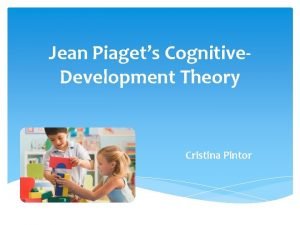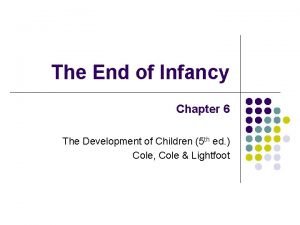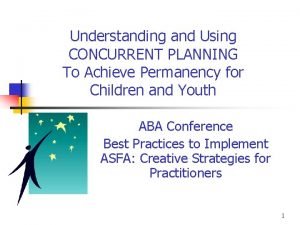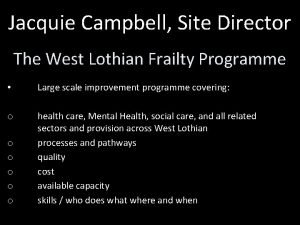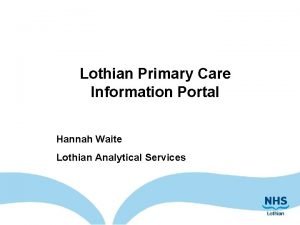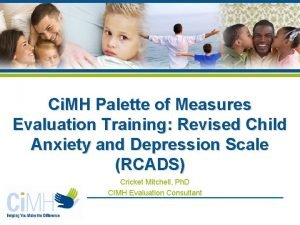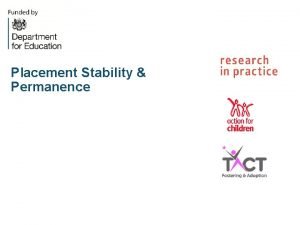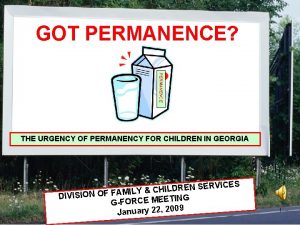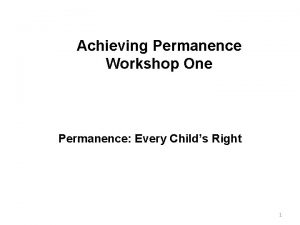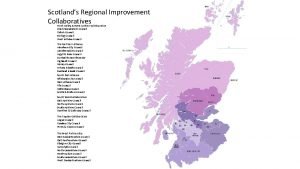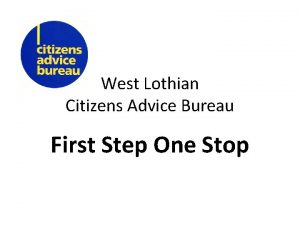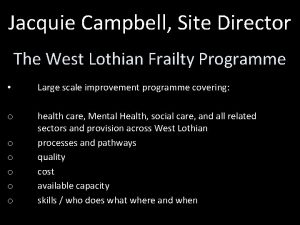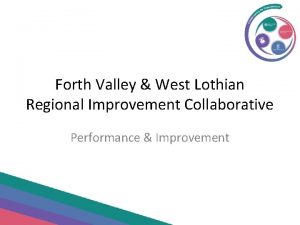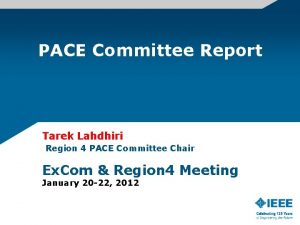Welcome to PACE in West Lothian THE PERMANENCE































































- Slides: 63

Welcome to PACE in West Lothian THE PERMANENCE AND CARE EXCELLENCE PROGRAMME (PACE) Reducing drifting and delay in permanence planning for looked after children to improve outcomes Carol Wassell, Permanence and Care Team Lead, CELCIS Kirsty Doull, Permanence Consultant, CELCIS Carol Ann Anderson, Data Analyst, CELCIS

Housekeeping

Why PACE in West Lothian Jo Mac. Pherson, Head of Social Policy

What you want from the next two days? One thing people may not know about you



Emotional, physical and legal permanence Emotional: Opportunity to build nurturing long-term relationships (including relationships with professionals) Legal: Legally secured permanence through removal of compulsory measures at home, Permanence Orders, Kinship Care Orders, and Adoption Orders Physical: minimum number of placement moves before child/young person is in a stable and secure home, where possible within a family setting that continues into adulthood

Four routes to permanence Adoption Home with parents Permanence Order Section 11 Kinship Care order

What we know What we want

Aim 1 Aim 2 Children who have been looked after at home for more than 2 years will have 24 -month review looking at their whole period of time being looked after at home on a Compulsory Supervision Order (CSO). Children who become looked after & accommodated will have a recommendation for Permanence (including permanent return home) within 26 weeks of becoming looked after and accommodated. Aim 3 Aim 4 Children who have had a recommendation for permanence away from home will have the decision ratified by the Agency Decision Maker within 14 weeks of the Looked After Review that recommended permanence. Children whose plan has been approved by the Agency Decision Maker will have their application for a legal order lodged within 4 weeks of agreement of the recommendation.


0 1/25/2011 6/19/2012 4/12/2013 4/17/2013 8/23/2013 10/14/2013 12/11/2013 1/22/2014 3/5/2014 3/6/2014 4/30/2014 7/1/2014 7/28/2014 8/18/2014 9/11/2014 10/13/2014 12/17/2014 5/20/2015 6/4/2015 7/6/2015 2/18/2016 2/26/2016 3/10/2016 3/17/2016 4/19/2016 4/20/2016 5/13/2016 5/17/2016 5/18/2016 5/19/2016 5/25/2016 6/7/2016 6/29/2016 8/15/2016 8/31/2016 10/27/2016 11/22/2016 8/17/2017 8/22/2017 8/31/2017 11/8/2017 11/14/2017 Looked After away from home start Date to LAC Review Week Recommendation (Weeks) 300 250 200 0 1 1 2 5 4 7 6 7 Guidance: 26 wks 350 Every dot is a child 150 100 50 49. 4 Date of LAC Review Recommendation Looked After & Accommodated Children Awaiting LAC Review with Recommendation: By Year 50 39 6 7 7 14 19 4 2005 2006 2007 2008 2009 2010 2011 2012 2013 2014 2015 2016 2017 2018


“You can’t fatten a cow by weighing it…” Palestinian proverb Improvement is not all about measurement, but if you can’t measure it, how do you know it’s an improvement?

Why choose PACE? • Reduced drift & delay = better outcomes for looked after children • Empowerment to lead change & drive sustainable improvements – making improvement work “business as usual” • Better recording & collection of data

Time for a break

West Lothian Data www. celcis. org

West Lothian PACE Project Looked After Children/ Young People 30 April 2019 www. celcis. org

National Overview • Reporting Period: 1 st Aug 2017 – 31 st Jul 2018 Source: Children Looked After Statistics (CLAS) www. celcis. org

CLAS: Looked After by Year Looked After Children/ Young People: By Year & Placement Type 600 511 500 449 447 445 418 415 434 449 443 400 300 200 100 0 2011 2012 2013 2014 2015 Parents n Kinship n Foster care n Community n Residential n Total n www. celcis. org 2016 2017 2018 Prospective Adopters www. celcis. org

West Lothian Scotland CLAS: Placements 2017/18 At home with parents 0% 10% 20% 30% 40% 50% 60% 51. 1% Eilean Siar Inverclyde East Renfrewshire North Lanarkshire Orkney Islands Stirling South Ayrshire Renfrewshire Dumfries & Galloway North Ayrshire Falkirk Argyll & Bute East Ayrshire Clackmannanshire South Lanarkshire East Lothian Midlothian Highland West Dunbartonshire West Lothian Angus Scotland Shetland Islands Edinburgh, City of Perth & Kinross Scottish Borders East Dunbartonshire Aberdeenshire Dundee City Fife Aberdeen City Moray Glasgow City 39. 4% 37. 6% 37. 5% 36. 8% 35. 5% 34. 6% 33. 5% 31. 7% 31. 6% 31. 5% 29. 7% 29. 5% 29. 1% 28. 6% 28. 5% 28. 2% 26. 5% 26. 2% 25. 5% 25. 3% 25. 0% 24. 8% 23. 8% 20. 6% 20. 4% 20. 3% 19. 6% 18. 3% 17. 7% 17. 4% 0% 10% 20% 30% 40% 50% North Lanarkshire East Dunbartonshire Dumfries & Galloway Argyll & Bute East Renfrewshire Scotland Inverclyde Renfrewshire West Lothian Stirling East Ayrshire South Ayrshire Midlothian Scottish Borders Perth & Kinross Angus North Ayrshire Edinburgh, City of Dundee City East Lothian South Lanarkshire Clackmannanshire Moray Highland Aberdeen City Fife Aberdeenshire Falkirk Eilean Siar Shetland Islands Orkney Islands 0% 10% 20% 30% 40% 50% 60% 0. 0% Orkney Islands 0% Moray 49. 6% Highland 48. 8% Falkirk 46. 1% 44. 0% East Dunbartonshire Aberdeenshire 43. 1% Stirling 41. 9% North Ayrshire 40. 8% Argyll & Bute 40. 0% Inverclyde 39. 3% South Lanarkshire 39. 0% Aberdeen City 37. 6% West Dunbartonshire 37. 5% Dundee City 37. 4% Midlothian 36. 0% West Lothian 35. 3% Scotland 34. 6% Scottish Borders 33. 7% East Ayrshire 33. 5% Clackmannanshire 32. 8% Perth & Kinross 32. 2% Edinburgh, City of 31. 9% Angus 31. 4% East Renfrewshire 30. 4% Fife 30. 2% East Lothian 28. 0% Renfrewshire 23. 1% South Ayrshire 22. 9% North Lanarkshire 21. 3% Glasgow City 21. 1% Dumfries & Galloway 20. 1% Shetland Islands 17. 3% Orkney Islands 16. 5% Fife 40. 7% 39. 7% Aberdeen City 39. 6% Aberdeenshire Dundee City 34. 0% Edinburgh, City of 33. 5% Moray 33. 1% Scottish Borders 28. 2% Angus 27. 8% East Lothian 27. 5% South Lanarkshire 27. 0% Clackmannanshire 26. 8% Shetland Islands 25. 7% Perth & Kinross 25. 4% Falkirk 25. 1% Scotland 25. 1% West Lothian 25. 0% East Ayrshire 24. 9% Glasgow City 24. 7% Midlothian 23. 6% Highland 22. 3% Renfrewshire 21. 8% South Ayrshire 21. 1% North Ayrshire 20. 8% East Dunbartonshire 20. 2% Dumfries & Galloway 20. 0% East Renfrewshire 19. 1% Stirling Eilean Siar 19. 0% Argyll & Bute 18. 4% West Dunbartonshire 16. 7% North Lanarkshire 13. 1% Inverclyde 12. 8% Glasgow City West Dunbartonshire All residential Foster care With friends/relatives 0. 0% Eilean Siar 5% 10% 15% 20% 17. 7% 17. 5% 15. 7% 15. 4% 13. 9% 13. 5% 13. 2% 12. 6% 12. 4% 11. 7% 11. 5% 11. 4% 11. 0% 10. 8% 10. 4% 10. 1% 9. 6% 8. 9% 8. 2% 8. 1% 7. 8% 7. 7% 7. 5% 7. 0% 6. 2% 5. 7% 4. 9% 4. 7% 0. 0%

West Lothian Council Dataset Data supplied for 430 looked after children/ young people as at 30 th April 2019 Source: West Lothian Council

Introduction to the ‘Model for Improvement’ www. celcis. org

The Model for Improvement ‘This model is not magic, but it is probably the most useful single framework I have encountered in twenty years of my own work on quality improvement’ Dr Donald M. Berwick Former Administrator of the Centres for Medicare & Medicaid Services Professor of Paediatrics and Health Care Policy at the Harvard Medical School

Model for Improvement www. celcis. org


Tests of Change Booklet Some examples of ideas we have tested in other PACE areas

‘Every system is perfectly designed to achieve the results it achieves’, (Berwick) Or… If you always do what you have always done, you will always get what you have always got.


Need to want to improve – buy in & commitment Will Come up with alternatives to the status quo Ideas Execution Make it real & do it

Deming’s Lens of Profound Knowledge

4 things to understand when trying to change a system Understand your system Understand variation Theory of knowledge (change theory) Human side of change

Understand your system • You need to know how your system is currently working in order to see where areas of drift and delay are – then you know where to focus your improvement efforts. • Look at how your processes actually work – not just what your policies say. • Look at what your data is telling you – crucial! • Can use tools to help…

• Process mapping • Force Field analysis • Cause and Effect analysis

Variation Measure 1 – Time taken to present a child at Permanence Panel from Permanence Decision Every dot is a child Measure 2– children still to get to Panel *Kinship panel date used for Kinship Children When these children are presented to panel they will no longer appear here but in measure 1 Picture Source : Carol Wassell

Human side of change

“Strong evidence for an innovation is necessary but not sufficient to result in adoption” Mark Freeman 2012 ‘The International Journal of Management Education’ “You can’t impose anything on anyone and expect them to be committed to it” Edgar Schein, Professor Emeritus MIT Sloan School

Theory of knowledge (change theory)

Time for lunch

Develop aim & change theory

Sense of Direction clip

An improvement aim Provides a clear sense of what we are trying to accomplish An improvement aim… Measurable – how much by when? Specific – who, where? Unachievable by hard work alone

What is your Aim? What? Be specific and clear about what you are trying to achieve. How much? %? All looked after children? “By when” for “from”? Clear timeframe.

Aim Examples • By December 2019, 90% of children who become looked after and accommodated will have a decision for permanence within 10. 5 months. • By May 2020, 60% of children who have a decision for permanence away from home, will be presented to the ADM within 35 weeks (for children who have a Permanence LAC review after 31 st March 2019) • By January 2020, 85% of children and young people will be registered within 25 weeks of the review where a decision to pursue permanence is made.


West Lothian, best approach to permanence in the world THE BAD

“As directed by our senior leadership in West Lothian our timescales for getting children from point A in their permanence journey to point B and from B to C will be above the 50 th percentile in Scotland by the end of the 2 nd Quarter of 2020” THE UGLY

By November 2019, 90% of looked after and accommodated children in West Lothian, who have a will be presented to the Adoption & Permanence Panel within 12 weeks of LAC review decision to rule out rehabilitation THE GOOD

4 PACE Aims • Covering the main milestone points on a child’s journey • Evidence from other PACE areas that these have the most impact • Keeps a national overview on how PACE is progressing • Other Aims or Sub-Aims for your context

Let’s start developing our PACE Aims for West Lothian


Building our Force Field Analysis • For listing, discussing, and assessing the various forces for and against a proposed change • Helps identify those factors that must be addressed and monitored if change is to be successful • Over to you!

Force field analysis for …. Forces for change Forces resisting change Reducing drift and delay in permanence planning for looked after children in West Lothian

Driver Diagrams www. celcis. org

Driver Diagrams: a way of capturing your change theory/theory of knowledge What is a Driver Diagram? • One page plan of how we will meet our Aim. • Shows, at a glance, all the things we need to be attending to in order to meet our Aim. • Lists all our change ideas for an Aim. • Shows how each change idea ties in to overall Aim. • Communication tool – easy to show someone what we are doing. • Living document – should be updated to include new change ideas, revisals to Aim, any new drivers, etc.

DRIVER DIAGRAM Aim In order to achieve this Aim… Primary Drivers we need to ensure that we… Key factors that drive the Aim Secondary Drivers which requires… Secondary factors that influence delivery of Primary Drivers Change Ideas these specific things that we will do Changes that we will test

Why use a Driver Diagram? • Supports team to explore all factors that will help achieve the Aim • Helps identify measures • Provides an improvement route map • Communication tool

Weight Loss Driver Diagram In your groups, identify the: • Aim • Primary Drivers • Secondary Drivers • Change Ideas

Weight Loss Driver Diagram Aim Primary Drivers Energy In Lose 2 stone by end December 2018 Secondary Drivers Change Ideas Reduce sugar intake No sweets on weekdays Reduce alcohol intake No pub on weekdays Healthy eating Take healthy lunches to work Walk more Walk 10, 000 steps a day Exercise more 3 gym classes per week Energy Out

Argyll & Bute Aim 2 Driver Diagram – accommodation to permanence recommendation Aim By 31 March 2020, 80% of children who become looked after and accommodated, on or after 1 March 2019, will have a recommendation for permanence made within 30 weeks (7 months) of becoming accommodated. Primary Drivers Child-centred multi-agency reports & tools Secondary Drivers Intensive assessment work as soon as child accommodated = implemented ideas * = ideas we are developing 2 Week Child’s Planning Meeting to set deadlines for assessments & reports Streamlined & more child friendly child’s plan Start parenting assessment at time of accommodation Better communication with Legal & SCRA Social Work confidence in using evidence Getting Legal involved earlier Early referral to SCRA Increase knowledge & understanding of permanence Legal advice before LAC Review that makes permanence recommendation Children who become looked after & accommodated referred by 72 Hour Planning Meeting Hold a rolling multi-agency programme focusing on permanence Visual Timeline to show child’s chronology at Children’s Hearings Peer coaching & mentoring Joint training re. contact with Social Work, Children’s Hearings, SCRA & Legal Timely kinship care assessments Child-focused planning Not to start again if child moves placement Kinship Care Panels to approve/review kinship carers and child’s plans where kinship care is the recommended plan Still hold 72 Hour Planning Meeting, but continue with existing cycle of review 6 June 2019 * Updating assessment tools Oban testing – but spreading to other localities Bold = ideas we are testing Change Ideas *

Tomorrow… Will be working on your Driver Diagrams for your Aims

Reflections on Day 1

What worked well today? What could be “even better if…” about today? Thank you - see you tomorrow!
 West lothian council building services
West lothian council building services Pace sia pace a voi
Pace sia pace a voi Do dogs have object permanence
Do dogs have object permanence Wat is permanence
Wat is permanence Emotional permanence
Emotional permanence Object permanence
Object permanence Concurrent planning definition
Concurrent planning definition Jane rimer
Jane rimer Corporate spirit
Corporate spirit Lothian primary care
Lothian primary care Alan hush nhs lothian
Alan hush nhs lothian Paul lothian
Paul lothian Fletcher v. rylands
Fletcher v. rylands East lothian health and social care partnership
East lothian health and social care partnership Old west vs new west
Old west vs new west What creates wind
What creates wind Horizontal movement of air
Horizontal movement of air Noord west zuid oost
Noord west zuid oost East is east and west is west
East is east and west is west Welcome welcome this is our christmas story
Welcome welcome this is our christmas story Tư thế worms-breton
Tư thế worms-breton ưu thế lai là gì
ưu thế lai là gì Tư thế ngồi viết
Tư thế ngồi viết Cái miệng bé xinh thế chỉ nói điều hay thôi
Cái miệng bé xinh thế chỉ nói điều hay thôi Cách giải mật thư tọa độ
Cách giải mật thư tọa độ Các châu lục và đại dương trên thế giới
Các châu lục và đại dương trên thế giới Bổ thể
Bổ thể Tư thế ngồi viết
Tư thế ngồi viết Thẻ vin
Thẻ vin Thế nào là giọng cùng tên?
Thế nào là giọng cùng tên? Thơ thất ngôn tứ tuyệt đường luật
Thơ thất ngôn tứ tuyệt đường luật Chúa yêu trần thế
Chúa yêu trần thế Sự nuôi và dạy con của hổ
Sự nuôi và dạy con của hổ Từ ngữ thể hiện lòng nhân hậu
Từ ngữ thể hiện lòng nhân hậu Diễn thế sinh thái là
Diễn thế sinh thái là Vẽ hình chiếu vuông góc của vật thể sau
Vẽ hình chiếu vuông góc của vật thể sau Phép trừ bù
Phép trừ bù Tỉ lệ cơ thể trẻ em
Tỉ lệ cơ thể trẻ em Lời thề hippocrates
Lời thề hippocrates đại từ thay thế
đại từ thay thế Vẽ hình chiếu đứng bằng cạnh của vật thể
Vẽ hình chiếu đứng bằng cạnh của vật thể Quá trình desamine hóa có thể tạo ra
Quá trình desamine hóa có thể tạo ra Các môn thể thao bắt đầu bằng tiếng bóng
Các môn thể thao bắt đầu bằng tiếng bóng Công thức tính thế năng
Công thức tính thế năng Thế nào là mạng điện lắp đặt kiểu nổi
Thế nào là mạng điện lắp đặt kiểu nổi Hình ảnh bộ gõ cơ thể búng tay
Hình ảnh bộ gõ cơ thể búng tay Khi nào hổ con có thể sống độc lập
Khi nào hổ con có thể sống độc lập Các loại đột biến cấu trúc nhiễm sắc thể
Các loại đột biến cấu trúc nhiễm sắc thể Thế nào là sự mỏi cơ
Thế nào là sự mỏi cơ Phản ứng thế ankan
Phản ứng thế ankan Gấu đi như thế nào
Gấu đi như thế nào Thiếu nhi thế giới liên hoan
Thiếu nhi thế giới liên hoan điện thế nghỉ
điện thế nghỉ Một số thể thơ truyền thống
Một số thể thơ truyền thống Thế nào là hệ số cao nhất
Thế nào là hệ số cao nhất Trời xanh đây là của chúng ta thể thơ
Trời xanh đây là của chúng ta thể thơ Lp html
Lp html Sơ đồ cơ thể người
Sơ đồ cơ thể người Số.nguyên tố
Số.nguyên tố đặc điểm cơ thể của người tối cổ
đặc điểm cơ thể của người tối cổ Tia chieu sa te
Tia chieu sa te Các châu lục và đại dương trên thế giới
Các châu lục và đại dương trên thế giới Tempo in music is
Tempo in music is Rcads scoring excel sheet parent
Rcads scoring excel sheet parent


